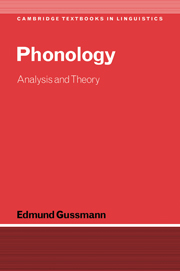Book contents
- Frontmatter
- Contents
- Preface
- List of abbreviations
- 1 Sounds and segments
- 2 The melody and the skeleton
- 3 Domains and phonological regularities
- 4 The syllable
- 5 More on codas
- 6 Some segmental regularities
- 7 Syllable structure and phonological effects: quantity in Icelandic
- 8 Segmental double agents
- 9 Words and feet: stress in Munster Irish
- Conclusion
- Appendix The phonetic alphabet of the International Phonetic Association
- References
- Index
Conclusion
Published online by Cambridge University Press: 05 June 2012
- Frontmatter
- Contents
- Preface
- List of abbreviations
- 1 Sounds and segments
- 2 The melody and the skeleton
- 3 Domains and phonological regularities
- 4 The syllable
- 5 More on codas
- 6 Some segmental regularities
- 7 Syllable structure and phonological effects: quantity in Icelandic
- 8 Segmental double agents
- 9 Words and feet: stress in Munster Irish
- Conclusion
- Appendix The phonetic alphabet of the International Phonetic Association
- References
- Index
Summary
The recurring theme in this book has been the realisation that things are not the way they look. We started by considering sounds and came to the conclusion that what are called sounds in everyday speech need to be broken up into separate levels or tiers. These embrace the tier of temporal positions, called the skeleton, and the tier of phonetic properties, called the melody. Furthermore, we saw on several occasions that the melody itself is a composite of units which act independently of other units within the melody.
The ordinary notion of the word has likewise turned out to require a reinterpretation in linguistic terms. We have seen that word-like units which function as separate entities for phonological purposes often comprise only parts of traditional (orthographic) words. What we need for phonology are domains which may but do not have to be coterminous with such words.
The difference between the ordinary and the linguistic usage of terms emerges most dramatically in the case of the syllable. While in everyday speech a word is said to be broken up into a number of consecutive syllables, we have seen that phonologically the situation is much more complex. The existence of empty nuclei and empty onsets introduces a basic divide between what ordinary intuitions prompt and what is required as a result of linguistic analysis. Similarly, membership in onsets or codas is not something which can be ascertained on the basis of an inspection of a phonetic sequence, but must result from a language-specific study within a framework which should be ready to accommodate any language.
- Type
- Chapter
- Information
- PhonologyAnalysis and Theory, pp. 224 - 225Publisher: Cambridge University PressPrint publication year: 2002



